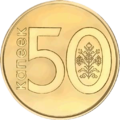Moneta zdawkowa
| Ten artykuł należy dopracować |
Moneta zdawkowa (rozmienna) – drobna jednostka monetarna, będąca częścią ułamkową (przeważnie 1/100) podstawowej jednostki w danym państwie.
Przykłady:
- grosz dla złotego i szylinga austriackiego,
- centavo w większości krajów Ameryki Łacińskiej,
- cent w wielu państwach (np. Stany Zjednoczone i państwa sfery anglojęzycznej oraz strefy euro),
- kopiejka dla rubla w carskiej Rosji, ZSRR, Federacji Rosyjskiej, Białorusi, Naddniestrzu,
- halerz dla korony czeskiej,
- lipa dla kuny chorwackiej.
Galeria
Filipińska moneta 50 centavos
50 kopiejek białoruskich
Media użyte na tej stronie
Autor: AKS.9955, Licencja: CC BY-SA 4.0
50 Philippines Centavos. Coin dates to 1964. Front (Obverse) of the coin, reads the denomination of the coin and year of minting on the periphery with a female standing beside hammer and anvil in the center. The Reverse of the coin reads Central Bank of the Philippines’ name and the Coat of arms of Philippines displayed in the center. Coin made of Copper-Nickel-Zinc alloy and the edges are reeded.
1 копейка Банка России
50 копеек Республики Беларусь образца 2009 года (реверс)













